1.3: Integers
- Page ID
- 5118
\( \newcommand{\vecs}[1]{\overset { \scriptstyle \rightharpoonup} {\mathbf{#1}} } \)
\( \newcommand{\vecd}[1]{\overset{-\!-\!\rightharpoonup}{\vphantom{a}\smash {#1}}} \)
\( \newcommand{\dsum}{\displaystyle\sum\limits} \)
\( \newcommand{\dint}{\displaystyle\int\limits} \)
\( \newcommand{\dlim}{\displaystyle\lim\limits} \)
\( \newcommand{\id}{\mathrm{id}}\) \( \newcommand{\Span}{\mathrm{span}}\)
( \newcommand{\kernel}{\mathrm{null}\,}\) \( \newcommand{\range}{\mathrm{range}\,}\)
\( \newcommand{\RealPart}{\mathrm{Re}}\) \( \newcommand{\ImaginaryPart}{\mathrm{Im}}\)
\( \newcommand{\Argument}{\mathrm{Arg}}\) \( \newcommand{\norm}[1]{\| #1 \|}\)
\( \newcommand{\inner}[2]{\langle #1, #2 \rangle}\)
\( \newcommand{\Span}{\mathrm{span}}\)
\( \newcommand{\id}{\mathrm{id}}\)
\( \newcommand{\Span}{\mathrm{span}}\)
\( \newcommand{\kernel}{\mathrm{null}\,}\)
\( \newcommand{\range}{\mathrm{range}\,}\)
\( \newcommand{\RealPart}{\mathrm{Re}}\)
\( \newcommand{\ImaginaryPart}{\mathrm{Im}}\)
\( \newcommand{\Argument}{\mathrm{Arg}}\)
\( \newcommand{\norm}[1]{\| #1 \|}\)
\( \newcommand{\inner}[2]{\langle #1, #2 \rangle}\)
\( \newcommand{\Span}{\mathrm{span}}\) \( \newcommand{\AA}{\unicode[.8,0]{x212B}}\)
\( \newcommand{\vectorA}[1]{\vec{#1}} % arrow\)
\( \newcommand{\vectorAt}[1]{\vec{\text{#1}}} % arrow\)
\( \newcommand{\vectorB}[1]{\overset { \scriptstyle \rightharpoonup} {\mathbf{#1}} } \)
\( \newcommand{\vectorC}[1]{\textbf{#1}} \)
\( \newcommand{\vectorD}[1]{\overrightarrow{#1}} \)
\( \newcommand{\vectorDt}[1]{\overrightarrow{\text{#1}}} \)
\( \newcommand{\vectE}[1]{\overset{-\!-\!\rightharpoonup}{\vphantom{a}\smash{\mathbf {#1}}}} \)
\( \newcommand{\vecs}[1]{\overset { \scriptstyle \rightharpoonup} {\mathbf{#1}} } \)
\( \newcommand{\vecd}[1]{\overset{-\!-\!\rightharpoonup}{\vphantom{a}\smash {#1}}} \)
\(\newcommand{\avec}{\mathbf a}\) \(\newcommand{\bvec}{\mathbf b}\) \(\newcommand{\cvec}{\mathbf c}\) \(\newcommand{\dvec}{\mathbf d}\) \(\newcommand{\dtil}{\widetilde{\mathbf d}}\) \(\newcommand{\evec}{\mathbf e}\) \(\newcommand{\fvec}{\mathbf f}\) \(\newcommand{\nvec}{\mathbf n}\) \(\newcommand{\pvec}{\mathbf p}\) \(\newcommand{\qvec}{\mathbf q}\) \(\newcommand{\svec}{\mathbf s}\) \(\newcommand{\tvec}{\mathbf t}\) \(\newcommand{\uvec}{\mathbf u}\) \(\newcommand{\vvec}{\mathbf v}\) \(\newcommand{\wvec}{\mathbf w}\) \(\newcommand{\xvec}{\mathbf x}\) \(\newcommand{\yvec}{\mathbf y}\) \(\newcommand{\zvec}{\mathbf z}\) \(\newcommand{\rvec}{\mathbf r}\) \(\newcommand{\mvec}{\mathbf m}\) \(\newcommand{\zerovec}{\mathbf 0}\) \(\newcommand{\onevec}{\mathbf 1}\) \(\newcommand{\real}{\mathbb R}\) \(\newcommand{\twovec}[2]{\left[\begin{array}{r}#1 \\ #2 \end{array}\right]}\) \(\newcommand{\ctwovec}[2]{\left[\begin{array}{c}#1 \\ #2 \end{array}\right]}\) \(\newcommand{\threevec}[3]{\left[\begin{array}{r}#1 \\ #2 \\ #3 \end{array}\right]}\) \(\newcommand{\cthreevec}[3]{\left[\begin{array}{c}#1 \\ #2 \\ #3 \end{array}\right]}\) \(\newcommand{\fourvec}[4]{\left[\begin{array}{r}#1 \\ #2 \\ #3 \\ #4 \end{array}\right]}\) \(\newcommand{\cfourvec}[4]{\left[\begin{array}{c}#1 \\ #2 \\ #3 \\ #4 \end{array}\right]}\) \(\newcommand{\fivevec}[5]{\left[\begin{array}{r}#1 \\ #2 \\ #3 \\ #4 \\ #5 \\ \end{array}\right]}\) \(\newcommand{\cfivevec}[5]{\left[\begin{array}{c}#1 \\ #2 \\ #3 \\ #4 \\ #5 \\ \end{array}\right]}\) \(\newcommand{\mattwo}[4]{\left[\begin{array}{rr}#1 \amp #2 \\ #3 \amp #4 \\ \end{array}\right]}\) \(\newcommand{\laspan}[1]{\text{Span}\{#1\}}\) \(\newcommand{\bcal}{\cal B}\) \(\newcommand{\ccal}{\cal C}\) \(\newcommand{\scal}{\cal S}\) \(\newcommand{\wcal}{\cal W}\) \(\newcommand{\ecal}{\cal E}\) \(\newcommand{\coords}[2]{\left\{#1\right\}_{#2}}\) \(\newcommand{\gray}[1]{\color{gray}{#1}}\) \(\newcommand{\lgray}[1]{\color{lightgray}{#1}}\) \(\newcommand{\rank}{\operatorname{rank}}\) \(\newcommand{\row}{\text{Row}}\) \(\newcommand{\col}{\text{Col}}\) \(\renewcommand{\row}{\text{Row}}\) \(\newcommand{\nul}{\text{Nul}}\) \(\newcommand{\var}{\text{Var}}\) \(\newcommand{\corr}{\text{corr}}\) \(\newcommand{\len}[1]{\left|#1\right|}\) \(\newcommand{\bbar}{\overline{\bvec}}\) \(\newcommand{\bhat}{\widehat{\bvec}}\) \(\newcommand{\bperp}{\bvec^\perp}\) \(\newcommand{\xhat}{\widehat{\xvec}}\) \(\newcommand{\vhat}{\widehat{\vvec}}\) \(\newcommand{\uhat}{\widehat{\uvec}}\) \(\newcommand{\what}{\widehat{\wvec}}\) \(\newcommand{\Sighat}{\widehat{\Sigma}}\) \(\newcommand{\lt}{<}\) \(\newcommand{\gt}{>}\) \(\newcommand{\amp}{&}\) \(\definecolor{fillinmathshade}{gray}{0.9}\)By the end of this section, you will be able to:
- Simplify expressions with absolute value
- Add and subtract integers
- Multiply and divide integers
- Simplify expressions with integers
- Evaluate variable expressions with integers
- Translate phrases to expressions with integers
- Use integers in applications
A more thorough introduction to the topics covered in this section can be found in the Elementary Algebra chapter, Foundations.
Simplify Expressions with Absolute Value
A negative number is a number less than 0. The negative numbers are to the left of zero on the number line (Figure \(\PageIndex{1}\)).

Figure \(\PageIndex{1}\). The number line shows the location of positive and negative numbers.
You may have noticed that, on the number line, the negative numbers are a mirror image of the positive numbers, with zero in the middle. Because the numbers \(2\) and \(−2\) are the same distance from zero, each one is called the opposite of the other. The opposite of \(2\) is \(−2\), and the opposite of \(−2\) is \(2\).
The opposite of a number is the number that is the same distance from zero on the number line but on the opposite side of zero.
Figure \(\PageIndex{2}\) illustrates the definition.

Figure \(\PageIndex{2}\). The opposite of 3 is \(−3\).
\[\begin{align} & -a \text{ means the opposite of the number }a \\ & \text{The notation} -a \text{ is read as “the opposite of }a \text{.”} \end{align} \]
We saw that numbers such as 3 and −3 are opposites because they are the same distance from 0 on the number line. They are both three units from 0. The distance between 0 and any number on the number line is called the absolute value of that number.
The absolute value of a number is its distance from 0 on the number line.
The absolute value of a number \(n\) is written as \(|n|\) and \(|n|≥0\) for all numbers.
Absolute values are always greater than or equal to zero.
For example,
\[\begin{align} & -5 \text{ is } 5 \text{ units away from 0, so } |-5|=5. \\ & 5 \text{ is }5\text{ units away from 0, so }|5|=5. \end{align}\]
Figure \(\PageIndex{3}\) illustrates this idea.

The absolute value of a number is never negative because distance cannot be negative. The only number with absolute value equal to zero is the number zero itself because the distance from 0 to 0 on the number line is zero units.
In the next example, we’ll order expressions with absolute values.
Fill in \(<,\,>,\) or \(=\) for each of the following pairs of numbers:
- \(\mathrm{|−5|}\_\_\mathrm{−|−5|}\_\_\mathrm{−|5|}\)
- \(\text{8__−|−8|}\)
- \(\text{−9__−|−9|}\)
- (\text{−(−16)__|−16|}\).
- Answer
-
a.
\(\begin{array}{lrcc} { \text{ } \\ \text{Simplify.} \\ \text{Order.} \\ \text{ } } & {|−5| \\ 5 \\ 5 \\ |−5|} & {\_\_ \\ \_\_ \\ > \\ >} & {−|−5| \\ −5 \\ −5 \\ −|−5|} \end{array}\)
b.
\(\begin{array}{llcc} { \text{ } \\ \text{Simplify.} \\ \text{Order.} \\ \text{ } } & {8 \\ 8 \\ 8 \\ 8} & {\_\_ \\ \_\_ \\ > \\ >} & {−|−8| \\ −8 \\ −8 \\ −|−8|} \end{array}\)
c.
\(\begin{array}{lrcc} { \text{ } \\ \text{Simplify.} \\ \text{Order.} \\ \text{ } } & {−9 \\ −9 \\ −9 \\ −9} & {\_\_ \\ \_\_ \\ = \\ =} & {−|−9| \\ −9 \\ −9 \\ −|−9|} \end{array}\)
d.
\(\begin{array}{lrcc} { \text{ } \\ \text{Simplify.} \\ \text{Order.} \\ \text{ } } & {−(−16) \\ 16 \\ 16 \\ −(−16)} & {\_\_ \\ \_\_ \\ = \\ =} & {−|−16| \\ 16 \\ 16 \\ |−16|} \end{array}\)
Fill in \(<,\,>,\) or \(=\) for each of the following pairs of numbers:
ⓐ \(−9 \_\_−|−9|\) ⓑ \(2 \_\_−|−2|\) ⓒ \(−8 \_\_|−8|\) ⓓ \(−(−9) \_\_|−9|.\)
- Answer
-
ⓐ \(>\) ⓑ \(>\) ⓒ \(<\)
ⓓ \(=\)
Fill in \(<,>,\) or \(=\) for each of the following pairs of numbers:
- \(7 \_\_ −|−7|\)
- \(−(−10) \_ \_|−10|\)
- \(|−4| \_\_ −|−4|\)
- \(−1 \_\_ |−1|.\)
- Answer
-
ⓐ \(>\) ⓑ \(=\) ⓒ \(>\)
ⓓ \(<\)
We now add absolute value bars to our list of grouping symbols. When we use the order of operations, first we simplify inside the absolute value bars as much as possible, then we take the absolute value of the resulting number.
\[\begin{array}{lclc} \text{Parentheses} & () & \text{Braces} & \{ \} \\ \text{Brackets} & [] & \text{Absolute value} & ||\end{array}\]
In the next example, we simplify the expressions inside absolute value bars first just like we do with parentheses.
Simplify: \(\mathrm{24−|19−3(6−2)|}\).
- Answer
-
\(\begin{array}{lc} \text{} & 24−|19−3(6−2)| \\ \text{Work inside parentheses first:} & \text{} \\ \text{subtract 2 from 6.} & 24−|19−3(4)| \\ \text{Multiply 3(4).} & 24−|19−12| \\ \text{Subtract inside the absolute value bars.} & 24−|7| \\ \text{Take the absolute value.} & 24−7 \\ \text{Subtract.} & 17 \end{array}\)
Simplify: \(19−|11−4(3−1)|\).
- Answer
-
16
Simplify: \(9−|8−4(7−5)|\).
- Answer
-
9
Add and Subtract Integers
So far in our examples, we have only used the counting numbers and the whole numbers.
\[\begin{array}{ll} \text{Counting numbers} & 1,2,3… \\ \text{Whole numbers} 0,1,2,3…. \end{array}\]
Our work with opposites gives us a way to define the integers. The whole numbers and their opposites are called the integers. The integers are the numbers \(…−3,−2,−1,0,1,2,3…\)
The whole numbers and their opposites are called the integers.
The integers are the numbers
\[…-3,-2,-1,0,1,2,3…,\]
Most students are comfortable with the addition and subtraction facts for positive numbers. But doing addition or subtraction with both positive and negative numbers may be more challenging.
We will use two color counters to model addition and subtraction of negatives so that you can visualize the procedures instead of memorizing the rules.
We let one color (blue) represent positive. The other color (red) will represent the negatives.

If we have one positive counter and one negative counter, the value of the pair is zero. They form a neutral pair. The value of this neutral pair is zero.

We will use the counters to show how to add:
\[5+3 \; \; \; \; \; \; −5+(−3) \; \; \; \; \; \; −5+3 \; \; \; \; \; \; \; 5+(−3)\]
The first example, \(5+3,\) adds 5 positives and 3 positives—both positives.
The second example, \(−5+(−3),\) adds 5 negatives and 3 negatives—both negatives.
When the signs are the same, the counters are all the same color, and so we add them. In each case we get 8—either 8 positives or 8 negatives.

So what happens when the signs are different? Let’s add \(−5+3\) and \(5+(−3)\).
When we use counters to model addition of positive and negative integers, it is easy to see whether there are more positive or more negative counters. So we know whether the sum will be positive or negative.

Add: ⓐ \(−1+(−4)\) ⓑ \(−1+5\) ⓒ \(1+(−5)\).
- Answer
-
ⓐ


1 negative plus 4 negatives is 5 negatives 
ⓑ

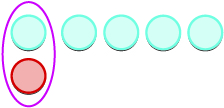
There are more positives, so the sum is positive. 
ⓒ

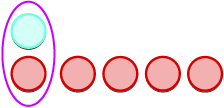
There are more negatives, so the sum is negative. 
Add: ⓐ \(−2+(−4)\) ⓑ \(−2+4\) ⓒ \(2+(−4)\).
- Answer
-
ⓐ \(−6\) ⓑ \(2\) ⓒ \(−2\)
Add: ⓐ \(−2+(−5)\) ⓑ \(−2+5\) ⓒ \(2+(−5)\).
- Answer
-
ⓐ \(−7\) ⓑ \(3\) ⓒ \(−3\)
We will continue to use counters to model the subtraction. Perhaps when you were younger, you read \(“5−3”\) as “5 take away 3.” When you use counters, you can think of subtraction the same way!
We will use the counters to show to subtract:
\[5−3 \; \; \; \; \; \; −5−(−3) \; \; \; \; \; \; −5−3 \; \; \; \; \; \; 5−(−3) \]
The first example, \(5−3\), we subtract 3 positives from 5 positives and end up with 2 positives.
In the second example, \(−5−(−3),\) we subtract 3 negatives from 5 negatives and end up with 2 negatives.
Each example used counters of only one color, and the “take away” model of subtraction was easy to apply.

What happens when we have to subtract one positive and one negative number? We’ll need to use both blue and red counters as well as some neutral pairs. If we don’t have the number of counters needed to take away, we add neutral pairs. Adding a neutral pair does not change the value. It is like changing quarters to nickels—the value is the same, but it looks different.
Let’s look at \(−5−3\) and \(5−(−3)\).
 |
 |
|
| Model the first number. |  |
 |
| We now add the needed neutral pairs. |  |
 |
| We remove the number of counters modeled by the second number. | 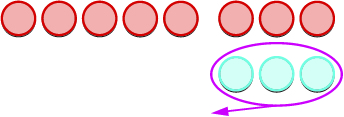 |
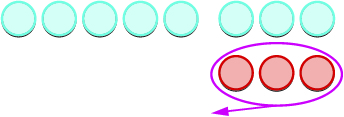 |
| Count what is left. |  |
 |
 |
 |
|
 |
 |
Subtract: ⓐ \(3−1\) ⓑ \(−3−(−1)\) ⓒ \(−3−1\) ⓓ \(3−(−1)\).
- Answer
-
ⓐ


Take 1 positive from 3 positives and get 2 positives. 
ⓑ


Take 1 positive from 3 negatives and get 2 negatives. 
ⓒ


Take 1 positive from the one added neutral pair. 

ⓓ


Take 1 negative from the one added neutral pair. 

Subtract: ⓐ \(6−4\) ⓑ \(−6−(−4)\) ⓒ \(−6−4\) ⓓ \(6−(−4)\).
- Answer
-
ⓐ \(2\) ⓑ \(−2\) ⓒ \(−10\) ⓓ \(10\)
Subtract: ⓐ \(7−4\) ⓑ \(−7−(−4)\) ⓒ \(−7−4\) ⓓ \(7−(−4)\).
- Answer
-
ⓐ \(3\) ⓑ \(−3\) ⓒ \(−11\) ⓓ \(11\)
Have you noticed that subtraction of signed numbers can be done by adding the opposite? In the last example, \(−3−1\) is the same as \(−3+(−1)\) and \(3−(−1)\) is the same as \(3+1\). You will often see this idea, the Subtraction Property, written as follows:
\[a−b=a+(−b)\]
Subtracting a number is the same as adding its opposite.
Simplify: ⓐ \(13−8\) and \(13+(−8)\) ⓑ \(−17−9\) and \(−17+(−9)\) ⓒ \(9−(−15)\) and \(9+15\) ⓓ \(−7−(−4)\) and \(−7+4\).
- Answer
-
ⓐ
\(\begin{array}{lccc} \text{} & 13−8 & \text{and} & 13+(−8) \\ \text{Subtract.} & 5 & \text{} & 5 \end{array}\)ⓑ
\(\begin{array}{lccc} \text{} & −17−9 & \text{and} & −17+(−9) \\ \text{Subtract.} & −26 & \text{} & −26 \end{array}\)
ⓒ
\(\begin{array}{lccc} \text{} & 9−(−15) & \text{and} & 9+15 \\ \text{Subtract.} & 24 & \text{} & 24 \end{array}\)
ⓓ
\(\begin{array}{lccc} \text{} & −7−(−4) & \text{and} & −7+4 \\ \text{Subtract.} & −3 & \text{} & −3 \end{array}\)
Simplify: ⓐ \(21−13\) and \(21+(−13)\) ⓑ \(−11−7\) and \(−11+(−7)\) ⓒ \(6−(−13)\) and \(6+13\) ⓓ \(−5−(−1)\) and \(−5+1\).
- Answer
-
ⓐ \(8,8\) ⓑ \(−18,−18\)
ⓒ \(19,19\) ⓓ \(−4,−4\)
Simplify: ⓐ \(15−7\) and \(15+(−7)\) ⓑ \(−14−8\) and \(−14+(−8)\) ⓒ \(4−(−19)\) and \(4+19\) ⓓ \(−4−(−7)\) and \(−4+7\).
- Answer
-
ⓐ \(8,8\) ⓑ \(−22,−22\)
ⓒ \(23,23\) ⓓ \(3,3\)
What happens when there are more than three integers? We just use the order of operations as usual.
Simplify: \(7−(−4−3)−9.\)
- Answer
-
\(\begin{array}{lc} \text{} & 7−(−4−3)−9 \\ \text{Simplify inside the parentheses first.} & 7−(−7)−9 \\ \text{Subtract left to right.} & 14−9 \\ \text{Subtract.} & 5 \end{array}\)
Simplify: \(8−(−3−1)−9.\)
- Answer
-
3
Simplify: \(12−(−9−6)−14.\)
- Answer
-
13
Multiply and Divide Integers
Since multiplication is mathematical shorthand for repeated addition, our model can easily be applied to show multiplication of integers. Let’s look at this concrete model to see what patterns we notice. We will use the same examples that we used for addition and subtraction. Here, we are using the model just to help us discover the pattern.
We remember that a⋅ba·b means add a, b times.
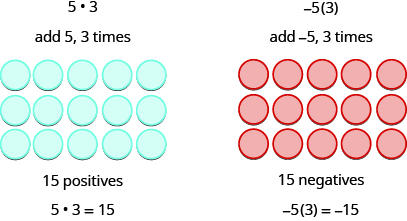
The next two examples are more interesting. What does it mean to multiply 5 by −3? It means subtract 5,3 times. Looking at subtraction as “taking away”, it means to take away 5, 3 times. But there is nothing to take away, so we start by adding neutral pairs on the workspace.
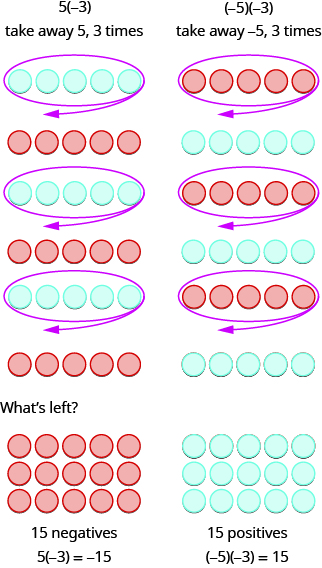
In summary:
\[\begin{array}{ll} 5·3=15 & −5(3)=−15 \\ 5(−3)=−15 & (−5)(−3)=15 \end{array}\]
Notice that for multiplication of two signed numbers, when the
\[ \text{signs are the } \textbf{same} \text{, the product is } \textbf{positive.} \\ \text{signs are } \textbf{different} \text{, the product is } \textbf{negative.} \]
What about division? Division is the inverse operation of multiplication. So, \(15÷3=5\) because \(15·3=15\). In words, this expression says that 15 can be divided into 3 groups of 5 each because adding five three times gives 15. If you look at some examples of multiplying integers, you might figure out the rules for dividing integers.
\[\begin{array}{lclrccl} 5·3=15 & \text{so} & 15÷3=5 & \text{ } −5(3)=−15 & \text{so} & −15÷3=−5 \\ (−5)(−3)=15 & \text{so} & 15÷(−3)=−5 & \text{ } 5(−3)=−15 & \text{so} & −15÷(−3)=5 \end{array}\]
Division follows the same rules as multiplication with regard to signs.
For multiplication and division of two signed numbers:
| Same signs | Result |
|---|---|
| • Two positives | Positive |
| • Two negatives | Positive |
If the signs are the same, the result is positive.
| Different signs | Result |
|---|---|
| • Positive and negative | Negative |
| • Negative and positive | Negative |
If the signs are different, the result is negative.
Multiply or divide: ⓐ \(−100÷(−4)\) ⓑ \(7⋅6\) ⓒ \(4(−8)\) ⓓ \(−27÷3.\)
- Answer
-
ⓐ
\(\begin{array}{lc} \text{} & −100÷(−4) \\ \text{Divide, with signs that are} \\ \text{the same the quotient is positive.} & 25 \end{array}\)
ⓑ
\(\begin{array} {lc} \text{} & 7·6 \\ \text{Multiply, with same signs.} & 42 \end{array}\)
ⓒ
\(\begin{array} {lc} \text{} & 4(−8) \\ \text{Multiply, with different signs.} & −32 \end{array}\)
ⓓ
\(\begin{array}{lc} \text{} & −27÷3 \\ \text{Divide, with different signs,} \\ \text{the quotient is negative.} & −9 \end{array}\)
Multiply or divide: ⓐ \(−115÷(−5)\) ⓑ \(5⋅12\) ⓒ \(9(−7)\) ⓓ\(−63÷7.\)
- Answer
-
ⓐ 23 ⓑ 60 ⓒ −63 ⓓ −9
Multiply or divide: ⓐ \(−117÷(−3)\) ⓑ \(3⋅13\) ⓒ \(7(−4)\) ⓓ\(−42÷6\).
- Answer
-
ⓐ 39 ⓑ 39 ⓒ −28 ⓓ −7
When we multiply a number by 1, the result is the same number. Each time we multiply a number by −1, we get its opposite!
\[−1a=−a\]
Multiplying a number by \(−1\) gives its opposite.
Simplify Expressions with Integers
What happens when there are more than two numbers in an expression? The order of operations still applies when negatives are included. Remember Please Excuse My Dear Aunt Sally?
Let’s try some examples. We’ll simplify expressions that use all four operations with integers—addition, subtraction, multiplication, and division. Remember to follow the order of operations.
Simplify: ⓐ \((−2)^4\) ⓑ \(−2^4\).
- Answer
-
Notice the difference in parts (a) and (b). In part (a), the exponent means to raise what is in the parentheses, the −2 to the 4thpower. In part (b), the exponent means to raise just the 2 to the 4th power and then take the opposite.
ⓐ
\(\begin{array}{lc} \text{} & (−2)^4 \\ \text{Write in expanded form.} & (−2)(−2)(−2)(−2) \\ \text{Multiply.} & 4(−2)(−2) \\ \text{Multiply.} & −8(−2) \\ \text{Multiply.} & 16 \end{array}\)ⓑ
\(\begin{array}{lc} \text{} & −2^4 \\ \text{Write in expanded form.} & −(2·2·2·2) \\ \text{We are asked to find} & \text{} \\ \text{the opposite of }24. & \text{} \\ \text{Multiply.} & −(4·2·2) \\ \text{Multiply.} & −(8·2) \\ \text{Multiply.} & −16 \end{array}\)
Simplify: ⓐ \((−3)^4\) ⓑ \(−3^4\).
- Answer
-
ⓐ 81 ⓑ −81
Simplify: ⓐ \((−7)^2\) ⓑ \(−7^2\).
- Answer
-
ⓐ 49 ⓑ −49
The last example showed us the difference between \((−2)^4\) and \(−2^4\). This distinction is important to prevent future errors. The next example reminds us to multiply and divide in order left to right.
Simplify: ⓐ \(8(−9)÷(−2)^3\) ⓑ \(−30÷2+(−3)(−7)\).
- Answer
-
ⓐ
\(\begin{array}{lc} \text{} & 8(−9)÷(−2)^3 \\ \text{Exponents first.} & 8(−9)÷(−8) \\ \text{Multiply.} & −72÷(−8) \\ \text{Divide.} & 9 \end{array}\)
ⓑ
\(\begin{array}{lc} \text{} & −30÷2+(−3)(−7) \\ \text{Multiply and divide} \\ \text{left to right, so divide first.} & −15+(−3)(−7) \\ \text{Multiply.} & −15+21 \\ \text{Add.} & 6 \end{array}\)
Simplify: ⓐ \(12(−9)÷(−3)^3\) ⓑ \(−27÷3+(−5)(−6).\)
- Answer
-
ⓐ 4 ⓑ 21
Simplify: ⓐ \(18(−4)÷(−2)^3\) ⓑ \(−32÷4+(−2)(−7).\)
- Answer
-
ⓐ 9 ⓑ 6
Evaluate Variable Expressions with Integers
Remember that to evaluate an expression means to substitute a number for the variable in the expression. Now we can use negative numbers as well as positive numbers.
Evaluate \(4x^2−2xy+3y^2\) when \(x=2,y=−1\).
- Answer
-



Simplify exponents. 
Multiply. 
Subtract. 
Add. 
Evaluate: \(3x^2−2xy+6y^2\) when \(x=1,y=−2\).
- Answer
-
31
Evaluate: \(4x^2−xy+5y^2\) when \(x=−2,y=3\).
- Answer
-
67
Translate Phrases to Expressions with Integers
Our earlier work translating English to algebra also applies to phrases that include both positive and negative numbers.
Translate and simplify: the sum of 8 and −12, increased by 3.
- Answer
-
\(\begin{array}{lc} \text{} & \text{the } \textbf{sum } \underline{\text{of}} \; –8 \; \underline{\text{and}} −12 \text{ increased by } 3 \\ \text{Translate.} & [8+(−12)]+3 \\ \text{Simplify. Be careful not to confuse the} \; \; \; \; \; \; \; \; \; \; & (−4)+3 \\ \text{brackets with an absolute value sign.} \\ \text{Add.} & −1 \end{array}\)
Translate and simplify the sum of 9 and −16, increased by 4.
- Answer
-
\((9+(−16))+4;−3\)
Translate and simplify the sum of −8 and −12, increased by 7.
- Answer
-
\((−8+(−12))+7;−13\)
Use Integers in Applications
We’ll outline a plan to solve applications. It’s hard to find something if we don’t know what we’re looking for or what to call it! So when we solve an application, we first need to determine what the problem is asking us to find. Then we’ll write a phrase that gives the information to find it. We’ll translate the phrase into an expression and then simplify the expression to get the answer. Finally, we summarize the answer in a sentence to make sure it makes sense.
The temperature in Kendallville, Indiana one morning was 11 degrees. By mid-afternoon, the temperature had dropped to −9−9degrees. What was the difference in the morning and afternoon temperatures?

- Answer
-






The temperature in Anchorage, Alaska one morning was 15 degrees. By mid-afternoon the temperature had dropped to 30 degrees below zero. What was the difference in the morning and afternoon temperatures?
- Answer
-
The difference in temperatures was 45 degrees Fahrenheit.
The temperature in Denver was −6 degrees at lunchtime. By sunset the temperature had dropped to −15 degrees. What was the difference in the lunchtime and sunset temperatures?
- Answer
-
The difference in temperatures was 9 degrees.
- Read the problem. Make sure all the words and ideas are understood.
- Identify what we are asked to find.
- Write a phrase that gives the information to find it.
- Translate the phrase to an expression.
- Simplify the expression.
- Answer the question with a complete sentence.
Access this online resource for additional instruction and practice with integers.
- Subtracting Integers with Counters
Key Concepts
- \[\begin{align} & −a \text{ means the opposite of the number }a \\ & \text{The notation} −a \text{ is read as “the opposite of }a \text{.”} \end{align} \]
- The absolute value of a number is its distance from 0 on the number line.
The absolute value of a number n is written as \(|n|\) and \(|n|≥0\) for all numbers.
Absolute values are always greater than or equal to zero.
- \[\begin{array}{lclc} \text{Parentheses} & () & \text{Braces} & \{ \} \\ \text{Brackets} & [] & \text{Absolute value} & ||\end{array}\]
- Subtraction Property
\(a−b=a+(−b)\)
Subtracting a number is the same as adding its opposite. - For multiplication and division of two signed numbers:
If the signs are the same, the result is positive.Same signs Result • Two positives Positive • Two negatives Positive
If the signs are different, the result is negative.Different signs Result • Positive and negative Negative • Negative and positive Negative - Multiplication by \(−1\)
\(−1a=−a\)
Multiplying a number by \(−1\) gives its opposite.
- How to Use Integers in Applications.
- Read the problem. Make sure all the words and ideas are understood
- Identify what we are asked to find.
- Write a phrase that gives the information to find it.
- Translate the phrase to an expression.
- Simplify the expression.
- Answer the question with a complete sentence.
Glossary
- absolute value
- The absolute value of a number is its distance from \(0\) on the number line.
- integers
- The whole numbers and their opposites are called the integers.
- negative numbers
- Numbers less than \(0\) are negative numbers.
- opposite
- The opposite of a number is the number that is the same distance from zero on the number line but on the opposite side of zero.


